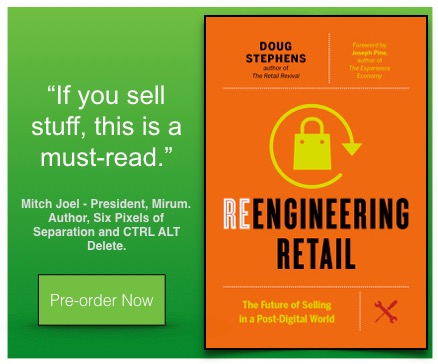
By Doug Stephens
Right now your company is very likely sitting on a corporate asset of immeasurable value. It’s more precious than all the equipment, machinery and buildings you own. It’s a tool so powerful it could reshape your company and perhaps even your entire industry. I would also wager that your organization has no idea where it’s kept, how much of it you possess or how to deploy it to your advantage.
I’m referring to human creativity.
Almost every company I work with claims to prize innovation. They extol it as a corporate virtue and core to their strategy. Most see innovation as inextricably baked into their brand values. And all seem to agree that the antidote to constant disruption is an equally constant level of innovation. In other words, innovation is the shit!
The problem is, I can easily count on one hand the number of companies that actually invest in identifying, measuring, nurturing or rewarding the human organizational creativity that fuels such innovation. This is particularly ironic because corporations are notorious for measuring even the most inconsequential and mind-numbing of things yet the vast value of creativity is most often overlooked or worse, it gets treated like black magic, something that simply occurs as spontaneously as lightening strikes. The upshot is that creativity is one of the least measured and most misunderstood assets a company possesses.
Consequently, while almost all companies aspire to be innovative, remarkably few ever actually are. And should we really be surprised? After all, how can you deploy the right people against innovation initiatives without understanding who your most creative employees are? How can you expect the organization to adopt innovation as a guiding mantra without nurturing it. How can you ask people to make time to innovate without rewarding the creativity that sparks it? Clearly you can’t and this is a problem, because there may not be any previous time in history when innovation has been more critical to business success.
So, if innovation and inventiveness are truly a priority for your organization, here are a few first steps to consider along the way to becoming more innovative:
- Avoid the leadership bias: Don’t assume that your most experienced leaders are also your most creative forces. Odds are they’re not. In fact there has been significant research to suggest that the more suited an individual is to leadership, the less inherently creative they are likely to be. Sure, there are the Steve Jobs and Elon Musks of the world but let’s face it, most leaders don’t work their way up the ladder by disrupting, challenging and pushing back against corporate norms. Yet this need to challenge the status quo is precisely what true creativity and innovation are all about. So, while your leaders may be super smart and great at what they do, this doesn’t make them creative. The tough part is how to break the news to them.
- Test for creativity: Equally problematic can be operating on the premise that everyone is equally capable of coming up with innovative ideas – they’re not. That said, you can test to see who is more or less creative. Your company likely already tests for intelligence quotient and emotional quotient so why not test for individual creativity quotients – that is, a person’s innate ability to produce inventive yet useful ideas. Creativity is absolutely something that can be benchmarked through a variety of widely accepted tests. By understanding in a systematic manner who your most creative people are, you’ll be better able to unleash the organization’s creative capability by calling upon the most capable innovators.
- Nurture Creativity: If you think creativity happens by sticking a group of people in a hotel conference room with a pot of coffee and a flip chart, you’re going to be sadly disappointed. Google’s Jonathan Rosenberg once said, “Creativity can be allocated, it can be budgeted, it can be measured, it can be tracked and encouraged but it can’t be dictated.” Creativity doesn’t come from a tap that you turn on when you need it. It’s an organic and fluid thing that can happen at any time. You can however, provide working conditions that are more conducive to fostering creative thinking. How and where people spend their working time can produce vast differences in
their creative output. - Reward Creativity: Most companies reward success and that’s a problem when it comes to innovation because many creative ideas are not successful in a convent
 ional business sense. They may not produce immediate gains in sales, profit, customer satisfaction or market share. However, that doesn’t mean they’re
ional business sense. They may not produce immediate gains in sales, profit, customer satisfaction or market share. However, that doesn’t mean they’re
not valuable or don’t help to evolve company strategy. Therefore, rewarding creativity means evaluating innovation on its own merits and celebrating the controlled but instructive failure that often accompanies it.
You can talk about innovation, you can wish for innovation but until you identify your most creative employees and give them the supportive culture and conditions in which to innovate, you’ll get nowhere. Only after you’ve begun to identify, nurture and reward creativity will you begin to see its spoils. And, if you’re like most organizations, chances are you’re sitting on a goldmine.

